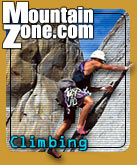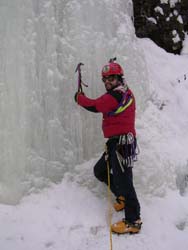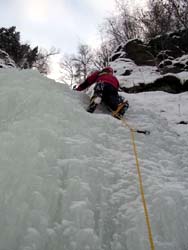
|
Alaskan Grade December 29, 2003 Pages »1 2
Our original plan was to do a winter alpine ascent of Pioneer and Matanuska mountains in Alaska. Unfortunately, we were forced to abandon our climbs due to high avalanche danger. While we were there in November/ December, several groups were caught in slides with some fatalities. So, we decided to spend two days ice climbing in Chugach State Park, which turned out to be a slightly different game than ice-climbing in the lower 48.
Day 1: Nov. 26, 2003 We followed in the tracks of three other climbers whom we'd chatted with in the parking lot 10 minutes before. A popular summer hike with boardwalks and scenic overlooks, the snow covered trail was empty as it wound up and down through now-naked birch forests. We paused for a view from an observation deck, the canyon below being reminiscent of Ouray's Box Canyon. Above, Bold Peak (7255') dominated the sky, the rising arctic sun crowning it in a dazzling golden brilliance. Every rippled snowfluting and undulating ridge was caught in high-relief light and shadow, the peak now flexing its sinews like a massive athlete.
Continuing onward a few hundred feet, we then stepped off the left edge of the trail. Here we cached the shoes and skis, and followed a small ridge down. Dry snow over frozen ground and downward fallen logs made for a banana peel descent. Crampons were accessible in my pack, but I threw caution to the wind being eager to see Alaskan ice. So I played Jane of the Jungle, grabbing for any sturdy looking birch trunk hanging in a low arc across my path, skidding downward in sequential jerky losses of balance. Where birch spacing was thin, devil's club was in abundance. Despite thorns bristling in all directions, well-situated stalks had obviously been grasped in a moment of desperation, as evidenced by stripped off bark and a few less spines. We laughed at the irony of needing a hand hold when only the dried remains of this wretched plant were available. Having made it safely to the canyon floor, we skirted the edge of the partially frozen Thunder Bird Creek. Ducking beneath ice covered branches and stepping over fallen birch logs, we took particular care to steer away from open holes from which muffled sounds of rushing water could be heard. We turned right at the junction of Thunder Bird and Eklutna creeks. After about 45 minutes, the unmistakable blue glow of water ice was visible on the right side of the canyon. "Ripple," a 165 foot, water-ice grade 3 (WI3) route filled a narrow gulley and looked fat! It consisted of a steep 25' curtain leveling off to a big ledge of compact snow with bolts on the right, then moderate ice to bolts on the left. It was already occupied by the party ahead of us. We visited with them again, and took their recommendation to check out another route a few more bends upstream after making a mental note to get on Ripple when they left.
Ten minutes later, we came to "Boonesfarm" WI2+, 180 feet in length. It had moderate ice to a steep bulge, then a crux pillar at the top which we'd learned could either be thick or thin. Checking it out while standing atop the frozen creek, I shoved a Snickers bar down the front of my Schoeller pants to make it edibly warm. Pete and I geared up: crampons, harnesses, rope, helmet, and ice tools. I wolfed the candy bar down between straps and buckles, all the while doing the ridiculous shuffling and kicking dance familiar to ice climbers in an effort to keep their feet warm. Colorado's sunshine and spring air temperatures had made me fall in love with ice climbing, but Alaska was doing its best now to convince me otherwise. Pete led out, making quick progress up the first pitch with confident swings and smooth progress. Belaying him, I stamped my feet forcefully trying to move warm blood downward while trying to sort out sounds of groaning ice or hollow areas beneath my boots. My feet had worsened from painfully cold, to numbing cold, to profound anesthesia. Between chunks of ice raining down on my helmet, I imagined the horror of later finding a broken toe in my sock, a small flesh icicle rolling around like a pebble. Pete continued upward and reached a bolted anchor in some sheltered rock and called out "Off belay!" I unclipped the rope from my ATC and parabiner, wishing him godspeed on building the anchor so I could get on the route. Minutes later, he pulled up the rope and I began.
Reaching the anchor, Pete met me with a broad smile and asked, "How goes it?" We discussed my podiatric problem, and decided to head back rather than risking frostbite. I bowed in deference to the Alaskan Grade and humbly acknowledged it, created to reflect the increased difficulty of climbs here due to extreme temperatures and/or grueling approaches. We would return and make our acquaintance with Ripple another day.
|
||||||||||||||||||


